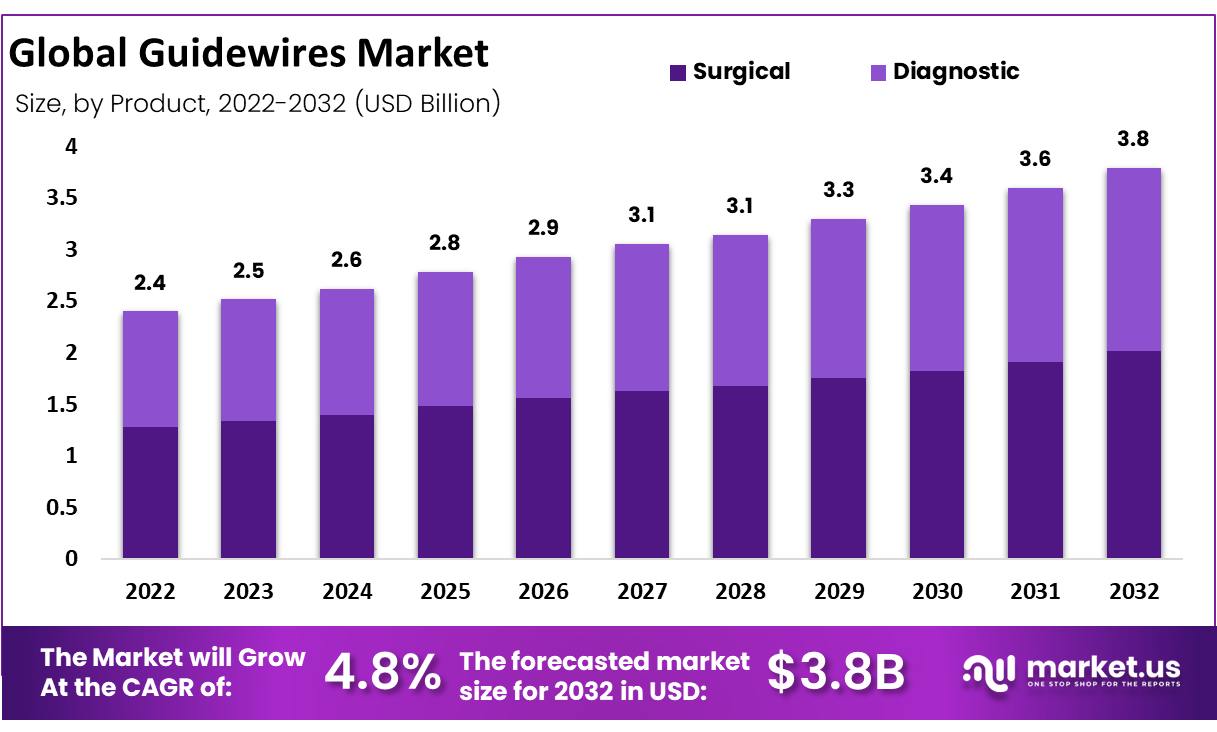Table of Contents
Introduction
The Global Guidewires Market is projected to grow from USD 2.4 billion in 2023 to USD 3.8 billion by 2032, at a CAGR of 4.8% during the forecast period. This growth is driven by the rising demand for minimally invasive surgeries. These procedures, widely adopted in medical practice, often require guidewires to navigate blood vessels efficiently, boosting their usage worldwide.
Technological advancements have significantly enhanced guidewire designs and materials, improving safety and performance. Innovations in these devices make them more reliable and preferred by healthcare providers. Regulatory guidance, such as the U.S. FDA’s recommendations for coronary, peripheral, and neurovascular guidewires, underscores their importance in ensuring safety and effectiveness. Additionally, devices like the Traxcess™ 14 SELECT Guidewire have received FDA clearance, further supporting market expansion.
The increasing prevalence of cardiovascular diseases is another major driver of market growth. As diagnostic and therapeutic interventions for conditions like heart diseases rise, the demand for guidewires in procedures like angioplasty has surged. This trend is especially evident in regions with high cardiovascular disease burdens, creating a robust need for advanced guidewire technologies.
The guidewires market’s growth is fueled by the rising adoption of minimally invasive surgeries, advancements in technology, the growing incidence of cardiovascular diseases, and supportive government approvals. These factors collectively create a positive outlook for the sector, ensuring continued innovation and development in the medical field.

Key Takeaways
- The global Guidewires Market is expected to reach USD 2.4 billion by the end of 2023, reflecting steady market growth.
- The market is projected to grow at a compound annual growth rate (CAGR) of 4.8% between 2022 and 2032.
- Guidewires technology is widely applied in gastrointestinal, cardiovascular, and interventional radiology procedures, showcasing its versatile medical usage.
- The surgical segment dominated the guidewires market in 2022, holding a notable 53.2% share of the total market revenue.
- In 2022, stainless steel guidewires generated the highest revenue share in the market, highlighting their preference over other materials.
- Coated guidewires led the market, accounting for 56.4% of total revenue in 2022 due to their enhanced functionality and safety features.
- The cardiology application segment is projected to witness significant growth during the forecast period, driven by increasing cardiovascular procedures globally.
- Hospitals and specialty clinics are expected to be the primary drivers of market demand during the forecast period due to increased healthcare access.
- North America dominated the global guidewires market, holding a substantial 46% revenue share in 2022, attributed to advanced healthcare infrastructure.
- Asia-Pacific is expected to record the fastest growth, with a projected CAGR of 8.4% during the forecast period, driven by expanding healthcare investments.
- Boston Scientific Corporation and Medtronic plc are key market players, collectively accounting for a significant portion of the guidewires market share.
Emerging Trends
- Advanced Coatings: Guidewires now use advanced coatings to improve movement through blood vessels. These include hydrophilic (water-attracting) and hydrophobic (water-repelling) materials. These coatings make guidewires slippery, reducing friction during procedures. This improvement minimizes the risk of vessel injury, enhancing patient safety. Advanced coatings also improve the overall efficiency of medical procedures by enabling smoother device navigation.
- Improved Biocompatibility: Nitinol, a flexible and body-friendly material, is increasingly used in guidewires. Its unique properties, such as flexibility and shape memory, enhance guidewire performance. Nitinol reduces the chances of adverse reactions in patients. This material ensures that guidewires can perform effectively without compromising patient safety. Its adoption highlights the focus on both functionality and biocompatibility in medical devices.
- Focus on Safety Standards: Regulatory agencies like the U.S. FDA are prioritizing safety in guidewire manufacturing. New regulations emphasize accurate labeling and stringent performance testing. These measures ensure that guidewires meet safety standards before reaching hospitals. This focus helps build trust in medical devices and ensures reliable performance during critical procedures. Enhanced regulation is driving innovation while safeguarding patient health.
Use Cases
- Coronary Interventions: Guidewires are essential in heart procedures. They help position catheters in coronary arteries to treat conditions like blockages. Their design allows them to navigate the intricate pathways of the heart’s blood vessels effectively. These guidewires enable precise catheter placement, making them vital in treating cardiovascular conditions. With their flexibility and maneuverability, they enhance the success rate of complex heart procedures.
- Peripheral Vascular Procedures: Guidewires play a key role in accessing blood vessels outside the heart and brain, such as those in the arms or legs. They are commonly used to place devices for treating conditions like peripheral artery disease. Their precision and ease of navigation allow healthcare professionals to perform procedures with minimal complications. This ensures effective treatment of blood vessel-related disorders.
- Neurovascular Applications: Guidewires are critical in treating delicate brain blood vessel conditions, such as aneurysms or strokes. Their flexibility and precision allow safe navigation through the brain’s intricate vascular system. They help deliver treatments with high accuracy, reducing risks during neurovascular procedures. Guidewires are indispensable in ensuring safe and effective care for complex neurological conditions.
Conclusion
The guidewires market is set to experience steady growth, driven by the increasing need for minimally invasive surgeries and advancements in technology. Rising cases of cardiovascular diseases and government support for medical innovations further boost the demand for guidewires. Enhanced safety features, such as advanced coatings and biocompatible materials, improve their functionality and patient outcomes, making them indispensable in medical procedures. With their critical role in coronary, peripheral, and neurovascular applications, guidewires remain essential for healthcare providers. Regions like North America and Asia-Pacific are leading this growth due to advanced healthcare infrastructure and expanding investments. The market is poised for continued development, fostering innovation and better patient care globally.
Discuss your needs with our analyst
Please share your requirements with more details so our analyst can check if they can solve your problem(s)



